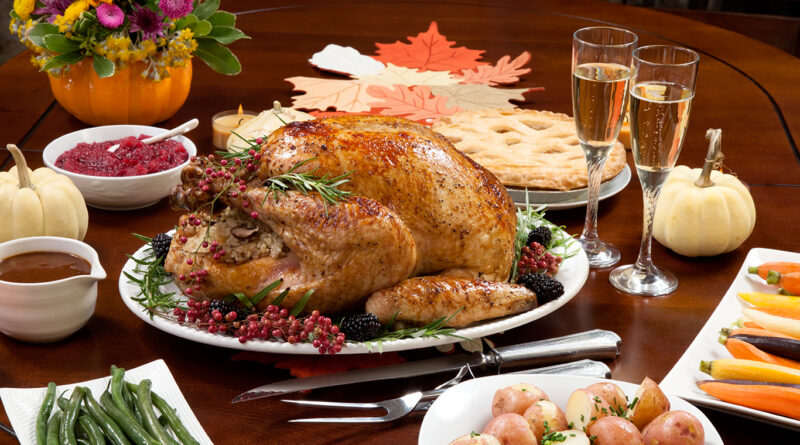Healthy, safe holiday meals
By CAREY STITES
 Whether you are preparing your first or 10th holiday meal, food safety in the kitchen is something all cooks should be mindful of at all times. By making certain you know the safest ways to thaw, prepare, stuff and cook a holiday meal you can assure friends and family enjoy amazing food and leave full of memories instead of stomachaches. This season, commit to knowing proper food safety principles to prevent food-borne illnesses from overrunning your holiday plans.
Whether you are preparing your first or 10th holiday meal, food safety in the kitchen is something all cooks should be mindful of at all times. By making certain you know the safest ways to thaw, prepare, stuff and cook a holiday meal you can assure friends and family enjoy amazing food and leave full of memories instead of stomachaches. This season, commit to knowing proper food safety principles to prevent food-borne illnesses from overrunning your holiday plans.
Thawing
A frozen turkey is a “safe” turkey, however, as soon as the turkey begins to thaw, bacteria perhaps present before freezing can begin to grow again. The “danger zone” is the temperature range of 40°F to 140°F where food borne bacteria grow most rapidly and can double in as little as 20 minutes.
When thawing a turkey in the refrigerator, allow about 24 hours for every 4-5 pounds. Most importantly, place the turkey in a container or on a tray, breast up, to prevent dripping juices from contaminating other foods while thawing.
If using the cold water thawing method, submerge the unopened turkey in enough water to cover it completely; change the water every 30 minutes. Plan a minimum thaw time of 30 minutes per pound and cook the turkey immediately after it has finished thawing.
Avoid thawing your turkey at room temperature as this encourages the growth of harmful bacteria in the danger zone.
Prepping
Cross-contamination refers to the spread of bacteria when juices from raw meats touch cooked foods or food preparation surfaces. Bacteria present on the uncooked turkey can contaminate hands, cooking utensils and work surfaces when the turkey is prepared for cooking.
Designate one area of the kitchen for specifically prepping the turkey along with utensils and cutting boards or plates; make it a priority to immediately clean the area and all items used (including hands) with soap and hot water. Antibacterial kitchen cleaners can be used on counters to ensure bacteria are no longer present.
Cooking
Stuffing your bird ahead of time is risky business. Food-borne bacteria grow rapidly be-cause the warm, moist stuffing sits inside the turkey (inside the refrigerator) for many hours before it gets below the danger zone.
Bacteria which are present multiply rampantly in this condition and even when the stuffing is out of the danger zone, the bacteria will not die but rather stop multiplying as quickly. Then the turkey goes into the oven and the cold stuffing takes a while to heat up due to the cooking position in the internal cavity of the turkey which puts it in the danger zone for hours.
Best bet? Cook stuffing outside the bird.
Most turkeys come equipped with a pop-up thermometer; however, best practice is to avoid relying on it and to use a meat thermometer instead to ensure the most accurate temperature. The magic temperature for a cooked turkey is 165°F as bacteria cannot survive above this temperature.
Use the meat thermometer to check the internal temperature of the turkey of the breast, thigh and wing joint and should you choose to stuff the bird, the stuffing must also reach a temperature of 165°F. If the turkey is removed and consumed before 165°F, the risk of salmonella exists and be passed on to the holiday guests.
Symptoms of salmonella typically develop 12 to 72 hours after eating and include diarrhea, abdominal cramps and fever, which can last four to seven days.
Storing
To minimize the time food stays in the “danger zone,” store leftovers in the refrigerator within two hours after cooking. Foods which stay at room temperature for more than two hours should be discarded.
Divide large amounts of hot foods, such as stuffing and mashed potatoes, into smaller portions to facilitate the cooling process; carve the turkey into small pieces before refrigerating.
Be sure to store leftovers in shallow airtight storage containers to keep bacteria away and to prevent your leftovers from drying out.
When it is time to eat the leftovers, reheat items to an internal temperature of 165°F to kill any possible bacteria.
Soups and gravies need to be reheated to a boil and when microwaving, stir the food halfway through to be sure the heat is distributed.
Typically, leftovers can be kept safely for three to four days in the refrigerator.
Have a Happy and Safe Holiday Season
One of the most important elements of the holiday is keeping in mind food safety issues involved in serving an amazing meal. Keep your friends and family free from food-borne illnesses and enjoy the wonderful time together this season!
Carey Stites, MS, RD, LD, CPT, is a registered and licensed dietitian in Harker Heights. She obtained a master’s degree in nutrition and dietetics from Texas Tech University has been a practicing dietitian since 2001. Carey is also an AFAA certified group fitness instructor and personal trainer; she has promoted health and wellness through presentations, classes, writing and cooking demonstrations all over Texas.



